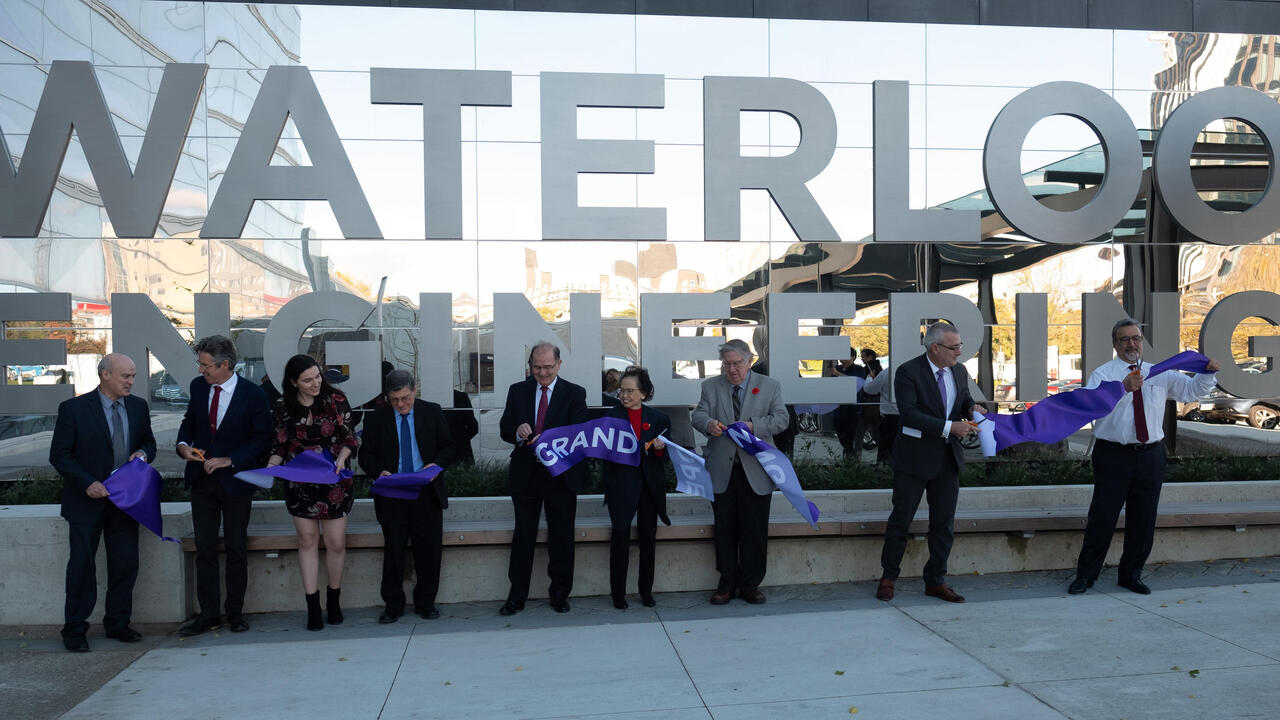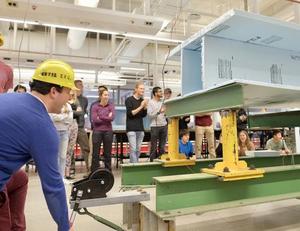
E7 opens with a bang, a reveal and a special delivery
New building 'a lot more than bricks and mortar'

New building 'a lot more than bricks and mortar'
By Brian Caldwell Faculty of EngineeringChamath Palihapitiya kept it light but heartfelt when he was announced as the largest private donor to the new Engineering 7 (E7) building as hundreds of people gathered to celebrate its official opening on October 29.

A 1999 Waterloo electrical engineering graduate who went on to tremendous success in business, Palihapitiya got a laugh when he joked via video clip about not being able to attend the event in person because an injury had forced him to fill in for the Golden State Warriors, the NBA basketball team he partly owns.
But the venture capitalist and former Facebook executive went on to give his alma mater high praise while explaining why he gave back by contributing $25 million to construction of the seven-storey, 242,000-square-foot building on the east campus.
“I would not be anywhere if it wasn’t for the things that happened to me at this school and my hope, my deepest desire, is that for many students they get some part, if not more than what I was able to get, which was self-confidence, resilience, access to opportunity and the ability to believe in the bigger future, and a bolder future, and then the courage to try and do something about it,” said Palihapitiya, dressed in a casual sweater.
The reveal of Palihapitiya was one of the highlights as Waterloo Engineering both welcomed guests to its $88-million gateway building and announced that its Educating the Engineer of the Future campaign topped $100 million in private sector donations from alumni, corporations and foundations.
The campaign contributed $37.3 million to the state-of-the-art E7, which is connected to its sister Engineering 5 (E5) building by a soaring, seven-storey atrium and enclosed pedestrian bridges, including one that is fitted with embedded sensors to record the forces generated on it.
The remaining campaign funds are earmarked for initiatives to enhance student experience, support graduate students and establish research chairs in emerging technologies.
Waterloo Engineering Dean Pearl Sullivan told dignitaries, donors and other guests that even the initial campaign target of $70 million was considered "kind of a dreamy number" for such a young faculty when the effort began five years ago.
“We had an ambitious goal and we exceeded it," she said. "It was possible because we worked together, we did it together."
The glass-walled, two-storey research and testing facility, a focal point on the ground floor of E7, sports TALOS, a full-size humanoid robot worth well over $1 million, along with a fleet of aerial, ground and magnetically-levitated robots.
"It's fascinating," said University staff member Debbie Collins as she watched TALOS in action. "Just imagine the advancements they're going to make and where it can all lead - medical, car-building, everything. This is far-reaching."
In addition to lecture halls, study spaces and special “garages” for project work by students in growing undergraduate programs, the building includes the two-floor Engineering Ideas Clinic™ for hands-on design challenges and activities to help teach theoretical concepts.
Teams of second-year civil engineering students energized the clinic during the official opening as they made bridges out of styrofoam, then tested the load-bearing capacities of their creations until they broke with resounding bangs.
Kevin Andrews, who works for RoboHub supplier Applanix, was touring E7 when he stopped to watch as students gathered around the testing apparatus.
"It's great - clearly everybody is engaged," he said. "I think I'm about to see something smash, which is always good."
E7 is home as well to the Conrad School of Entrepreneurship and Business, Outreach programs, a 3D-printing facility and dozens of labs for research in fields including 5G communications, blockchain, the Internet of Things and human-machine interaction.
“This building, this magnificent structure here, is a lot more than just a structure, a lot more than bricks and mortar,” said Feridun Hamdullahpur, president and vice-chancellor of Waterloo, recalling the University's humble beginnings in a trailer 61 years ago. “It carries decades of passion and decades of commitment.”
The federal government also made a key $32.6-million contribution to the building through a program to update research and innovation infrastructure.

Read more
Here are the people and events behind some of this year’s most compelling Waterloo stories

Read more
Meet five exceptional Waterloo graduate students crossing the convocation stage as Class of 2025 valedictorians

Read more
Waterloo Engineering alum wears her iron ring proudly while building her career in quantum tech in Germany
The University of Waterloo acknowledges that much of our work takes place on the traditional territory of the Neutral, Anishinaabeg, and Haudenosaunee peoples. Our main campus is situated on the Haldimand Tract, the land granted to the Six Nations that includes six miles on each side of the Grand River. Our active work toward reconciliation takes place across our campuses through research, learning, teaching, and community building, and is co-ordinated within the Office of Indigenous Relations.